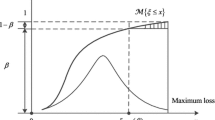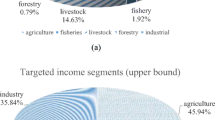Abstract
Many modifications, extensions, discussions, and evaluations of chance-constrained reservoir operating models have been reported in the technical literature. Lack of economic data and the fact that the establishment of acceptable risk levels in these types of models involves a human factor with all its vagueness of perception, subjectivity, and attitudes may not permit proper application of either reliability or multiobjective programming approaches. This paper presents a unique methodology for handling a practical problem of selecting risk levels in chance-constrained reservoir operation modeling. The proposed methodology is based on fuzzy set theory. Two types of fuzzy sets are used in the formulation of the reservoir long-term planning model, one for constraints and one for the objective function. An iterative solution algorithm for deriving an optimal decision using fuzzy set operations and the chance-constrained approach is developed and presented. A practical application of the approach demonstrates the feasibility and efficiency of both the proposed approach and its iterative search procedure for selecting risk levels in chance-constrained reservoir modeling.
Similar content being viewed by others
References
Bardossy, A., Bogardi, I., Duckstein, L., and Kelly, W. E., 1990, Fuzzy regression in hydrology, Water Resour. Res. 26(7), 1497–1508.
Bellman, R. E. and Zadeh, L. A., 1970, Decision-making in a fuzzy environment, Management Sci. 17(4), 141–164.
Bharathi, D. B. and Sarma, V. V. S., 1985, Estimation of fuzzy memberships for histograms, Inform. Sci. 43–59.
Bogardi, L. Bardossy, A., and Duckstein, L., 1983, Regional management of an aquifer for mining under fuzzy environmental objectives, Water Resour. Res. 19(6), 1394–1402.
Bras, R. L. Buchananan, R., and Curry, K. C., 1983, Real time adaptive closed loop control of reservoirs with the High Aswan dam as a case study, Water Resour. Res. 19(1), 33–52.
Brown, C. B., 1989, Civil engineering optimizing and satisficing, Papers presented at NATO Advanced Study Institute: Optimization and Decision Support Systems in Civil Engineering, Edinburgh, UK.
Changchit, C. and Terrell, M. P., 1989, CCGP model for multiobjective reservoir systems, J. Water Resour. Planning Management ASCE 115(5), 658–670.
Charnes, A. and Cooper, W. W., 1959, Change-constrained programming, Management Sci. 6(1), 73–79.
Charnes, A. and Cooper, W. W., 1983, Response to ‘Decision problems under risk and chance constrained programming: Dilemmas in the transition’, Management Sci. 29(6), 750–753.
Chu, A. T., Kalaba, R. e., and Spingarn, K., 1979, A comparison of two methods for determining the weights of belonging to fuzzy sets, J. Optim. Theory Appl. 27(4), 531–538.
Curry, G. L., Helm, J. C., and Clark, R. A., 1973, Chance-constrained model of system of reservoirs, J. Hydraulic Div. ASCE, 99 [HY12], 2353–2366.
Freeling, A. N. S., 1980, Fuzzy sets and decision analysis, IEEE Trans. Systems Man Cybernet. SMC 10(7), 341–354.
Hogan, J.A., Morris, J. G., and Thompson, H. E., 1981, Decision problems under risk and chance constrained programming: Dilemmas in the transition, Management Sci. 27(6), 698–716.
Jaroslav Cerni Institute, 1976, Water resources analysis of the Gruza Reservoir alternatives, Internal report (in Serbian).
Kindler, J., 1990, Water resources planning in the 90s: The case of resources allocation with imprecise demand estimates, Invited presentation at the International Symposium on Water Resources Systems Application, Winnipeg, Canada.
Loaiciga, H. A., 1988, On the use of chance constraints in reservoir design and operation modeling, Water Resour. Res. 24(11), 1969–1975.
Maiers, J. and Y. S. Sherif, 1985, Applications of fuzzy set theory, IEEE Trans. Systems Man Cybernet. SMC 15(1), 175–189.
Nachtnebel, H. P., Hanisch, P., and Duckstein, L., 1986, Multicriterion analysis of small hydropower plants under fuzzy objectives, Ann. Regional Sci. 20(3), 86–100.
Neter, J., Wasserman, W., and Kutner, M. H., 1989, Applied Linear Regression Models, Richard D. Irwin, Inc., Boston.
Palmer, R. N. and Lund, J. R., 1985, Multi-objective analysis with subjective information, J. Water Resour. Planning and Management ASCE 111(4), 399–416.
Pedrycz, W., 1989, Fuzzy Control and Fuzzy Systems, Research Studies Press Ltd., Somerset, England.
Rakes, R. and Reeves, R., 1985, Selecting tolerances in chance-constrained programming: A multiple objective linear programming approach, Oper. Res. Lett. 4(2), 65–69.
ReVelle, C., Joeres, E., and Kirby, W., 1969, The linear decision rule in reservoir management and design. 1, Development of the stochastic model, Water Resour. Res. 5(4), 767–777.
Saaty, T. L., 1977, A scaling method for priorities in hierarchical structures, J. Math. Psych. 15, 234–281.
Saaty, T. L., 1980, The Analytic Hierarchy Process, McGraw-Hill, New York.
Saaty, T. L. and Vargas, L. G., 1982, The Logic of Priorities, Kluwer-Nijhoff Publishing, Boston.
Sakawa, M., Yano, H., and Yumine, T., 1987, An interactive fuzzy satisficing method for multiobjective linear-programming problems and its application, IEEE Trans. Systems Man Cybern. SMC 17(4), 654–661.
Sengupta, J. K., 1972, Stochastic Programming. Methods and Applications, North-Holland, Amsterdam.
Simonovic, S. P., 1979, Two-step algorithm for design-stge long-term control of a multipurpose reservoir, Adv. Water Resour. 2, 47–49.
Simonovic, S. P. and Marino, M. A., 1981, Reliability programming in reservoir management 2. Riskloss functions, Water Resour. Res. 17(4), 822–826.
Simonovic, S. P., 1987, Comment on ‘Evaluation of a “Reliability Programming” reservoir model’ by J. B. Strycharczyk and J. R. Stedinger, Water Resour. Res. 23(9), 1795–1796.
Stedinger, J. R., 1984, The performance of LDR models for preliminary design of reservoir operation, Water Resour. Res. 20(2), 215–224.
Stedinger, J. R. and J. B. Strycharczyk, 1987, Reply, Water Resour. Res. 23(9), 1801–1802.
Strycharczyk, J. B. and Stedinger, J. R., 1987, Evaluation of a ‘Reliability programming’ reservoir model, Water Resour. Res. 23(2), 225–229.
Tanaka, H., Okuda, T., and Asai, K., 1974, On fuzzy-mathematical programming J. Cybern. 3(4) 37–46.
Uan-On, T. and Helweg, O. J., 1988, Deriving the nonlinear risk-benefit algorithm for reservoirs, Water Resour. Bull. 24(2), 261–268.
Westgate, J. T., 1980, Design of objective functions for reservoir operations, M Sc Thesis, Colorado State University, Fort Collins, Colorado.
Zadeh, L. A., 1965, Fuzzy sets, Inform. and Control 8, 338–353.
Zimmermann, H.-J., 1976, Description and Optimization of Fuzzy Systems, Internal. J. Gen. Systems 2, 209–215.
Zimmermann, H.-J., 1983, Using fuzzy sets in operational research, European J. Oper. Res. 13, 201–216.
Zimmermann, H.-J., 1985, Fuzzy Set Theory and Its Applications, Kluwer-Nijhoff Publishing, Boston.
Zimmermann, H.-J., 1987, Fuzzy Sets, Decision Making, and Expert Systems, Kluwer Academic Publishers, Dordrecht.
Zimmernann, H.-J., and Zysno, P., 1980, Latent connectives in human decision making, Fuzzy Sets and Systems 4, 37–51.
Author information
Authors and Affiliations
Rights and permissions
About this article
Cite this article
Savic, D.A., Simonovic, S.P. Selecting risk levels in chance-constrained reservoir operation modeling: A fuzzy set approach. Water Resour Manage 4, 251–271 (1991). https://doi.org/10.1007/BF00430340
Received:
Revised:
Issue Date:
DOI: https://doi.org/10.1007/BF00430340




